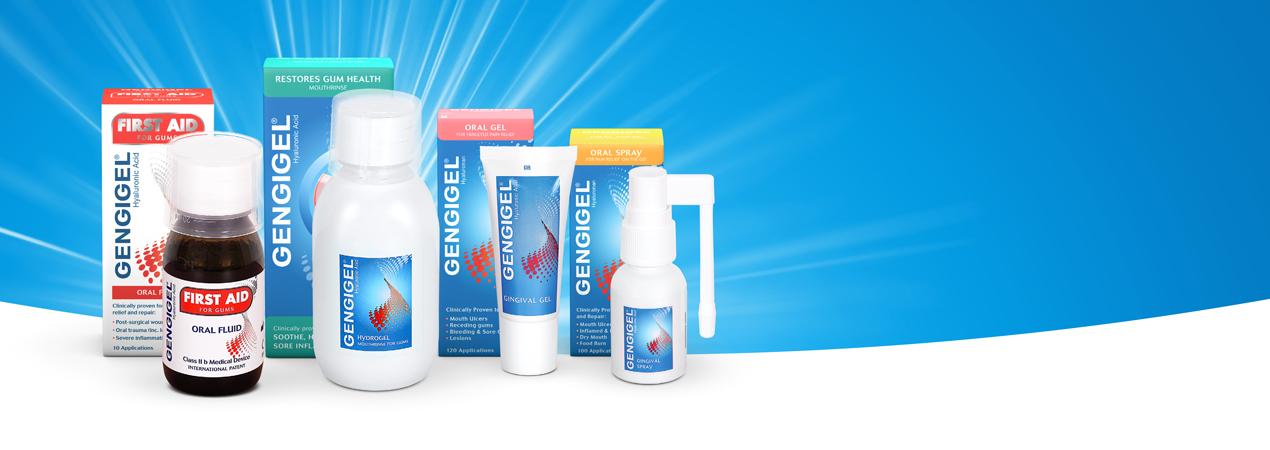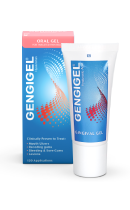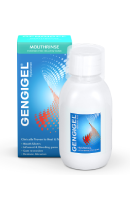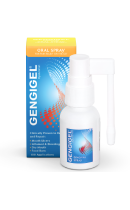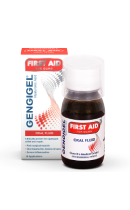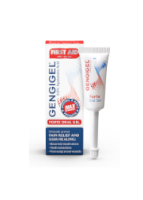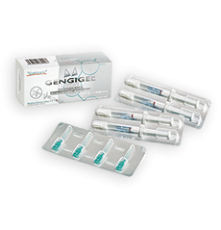Clinical Studies
Case Studies PDF
Download Gengigel case studies which assess the therapeutic benefits of hyaluronic acid to complete surgery and for post-operative wound healing. Download Here.
Alternatively, below you will find a Clinical Studies Summary.
Gingivitis
Local Injection of Hyaluronic Acid Filler Improves Open Gingival Embrasure: Validation Through a Rat Model. Pi S, Choi YJ, Hwang S, Lee DW, Yook JI, Kim KH, Chung CJ. Journal of Periodontol. 2017 Nov; 88(11): 1221-1230. Conclusion: Open gingival embrasure was reproduced reliably in vivo. Local injection of HA filler was validated as a meaningful minimally invasive procedure to improve open gingival embrasure.
Clinical Evaluation of Hyaluronan Gel v RSP in the treatment of Gingivitis. Dr Sapna. J Investig Clin Dent. 2011 Aug;2(3):162-70. Conclusion: Topical administration of Gengigel together with RSP was more effective than scaling alone or Gengigel alone.
Effectiveness of Hyaluronan in the therapy of gingivitis. Pistorius A., Rockmann P., Martin M., Willershausen B. Quintessence International 2005 36(7-8) pp.531-580. Conclusion: Gengigel effected significant improvements in the parameters of inflammation of gingivitis, SBI, PBI and CFFR. The study reported improved reductions in bleeding of 22.6% and 39.2% after 3 and 7 days.
Treatment of Gingivitis with Hyaluronan. Pomowski R., Kundt G., Gocke R., Jentsch H. Journal of Clinical Periodontology 2003, 30: 159-164. Conclusion: Gengigel was shown to have a beneficial effect in the treatment of plaque induced gingivitis in a randomised double-blind study. Rapid decrease in levels of peroxidase and lysozyme concentrations in the crevicular fluid were demonstrated leading to a significant reductions in inflammation. The study reported better reductions in bleeding after 21 days of daily application of hyaluronic acid gel by patients.
Double blind clinical trial vs. placebo of a new sodium hyaluronate-based gingival gel. Pagnacco A., Vangelisti R., Erra C., Poma A. International Dental Journal 1997. 15. Conclusion: As the result of the natural activity of HA Hyaluronic acid, Gengigel proved able to promote rapid remission of symptoms after the professional session when used twice a day for four weeks as a compliment to oral hygiene. Gengigel can be used to prevent relapsing episodes of gingivitis not only to the marginal mucosa but also to the deeper periodontal structures which can suffer gradual loss of attachment.
Periodontal Wound Healing
To what extent does hyaluronic acid affect healing of xenografts? A histomorphometric study in a rabbit model. Arpağ OF, Damlar I, Altan A, Tatli U, Günay A. J Appl Oral Sci. 2018 Jan 18;26. Conclusion: These results support that high molecular weight hyaluronic acid could contribute to the healing of xenograft by improving the percentage of new bone formation and reducing the percentage of residual graft.
Effects of Hyaluronic Acid and Hydroxyapatite/Beta-tricalcium Phosphate in Combination on Bone Regeneration of a Critical-size Defect in an Experimental Model. Diker N, Gulsever S, Koroglu T, Yilmaz Akcay E, Oguz Y. J Craniofac Surg. 2018 Feb 12. Conclusion: The healing parameters related to bone formation (new bone formation, defect closure, immature bone formation) were significantly higher in the Hyaluronic acid group compared with the control group.
The efficacy of hyaluronic acid in post-extraction sockets of impacted third molars: A pilot study. Yilmaz N, Demirtas N, Kazancioglu HO, Bayer S, Acar AH, Mihmanli A. Niger J Clin Pract. 2017 Dec; 20(12): 1626-1631. Conclusion: The results of this study showed that HA can produce an analgesic action in postextraction sockets after surgical removal of impacted teeth and therefore it has a clinical benefit to reduce usage of nonsteroidal anti-inflammatory drugs after dentoalveolar surgery.
Effect of Topically-Applied Hyaluronic-Acid on Pain and Palatal Epithelial Wound Healing: An Examiner-Blind, Randomized, Controlled Clinical Trial. Yıldırım S, Özener HÖ, Doğan B, Kuru B. Journal of Periodontol. 2017 Sep 15:1-14. Conclusion: Topical application of hyaluronic-acid exhibits positive impact on post-operative pain, burning sensation and accelerates palatal wound healing in terms of epithelization and colour match.
In vitro effects of hyaluronic acid on human periodontal ligament cells. Fujioka-Kobayashi M, Müller HD, Mueller A, Lussi A, Sculean A, Schmidlin PR, Miron RJ. BMC Oral Health. 2017 Jan 16; 17(1):44. Conclusion: Both non-cross-linked and cross-linked HA maintained high PDL cell viability, increased proliferation, and early osteogenic differentiation. However, HA was consistently associated with a significant decrease in late osteogenic differentiation of primary human PDL cells.
Effect of hyaluronic acid on morphological changes to dentin surfaces and subsequent effect on periodontal ligament cell survival, attachment, and spreading. Mueller A, Fujioka-Kobayashi M, Mueller HD, Lussi A, Sculean A, Schmidlin PR, Miron RJ. Clin Oral Investig. 2017 May; 21(4): 1013-1019. Conclusion: The results from the present study demonstrate that both carrier systems for HA were extremely biocompatible and demonstrated either improved cell numbers or cell spreading onto dentin discs.
An evaluation of 0.2% hyaluronic acid gel (Gengigel®) in the treatment of gingivitis: a clinical & microbiological study. Sahayata VN1, Bhavsar NV, Brahmbhatt NA. Oral Health Dent Manag. 2014 Sep; 13(3):779-85. Conclusion: Local application of 0.2 % HA gel adjunct to non-surgical periodontal treatment provided a significant improvement in clinical parameters than placebo control and negative control groups.
Efficacy of hyaluronic acid spray on swelling, pain, and trismus after surgical extraction of impacted mandibular third molars. Koray M, Ofluoglu D, Onal EA, Ozgul M, Ersev H, Yaltirik M, Tanyeri H. Int J Oral Maxillofac Surg. 2014 Nov;43(11): 1399-403. Conclusion: The administration of hyaluronic acid spray was more effective than benzydamine hydrochloride spray in reducing swelling and trismus. In addition, hyaluronic acid appears to offer a beneficial effect in the management of swelling and trismus during the immediate postoperative period following impacted third molar surgery.
Local delivery of hyaluronan as an adjunct to scaling and root planning in the treatment of chronic periodontitis. Johannsen A., Tellefsen M., Wikesjo U., Johannsen G. Journal of Periodontol 2009 80(9). pp. 1493-1497. Conclusion: Findings indicate that local application of hyaluronan gel in conjunction with scaling and root planing have clinically beneficial effects on periodontal health in patients with chronic periodontitis. Twelve patients with chronic periodontitis participated in a splitmouth study assessing plaque, bleeding and probing depths over a 12 week period. After full-mouth debridement, HA gel was placed subgingivally in the test sites and again after 1 week. Significantly better BOP and mean probing depths (P <0.05) were recorded for the HA group.
Evaluation of the effect of 0.8% hyaluronic acid gel as coadjuvant to nonsurgical periodontal therapy. Violant D, Mor C, Santos A. Pilot study: Dentum (2008); 8(4):149-154. Conclusion: This 3 month split mouth study on 4 patients with moderate-advanced periodontitis had HA applied on the test sides after each visit for debridement and showed significantly better reductions in PD and BI (p <0.05), and less gingival recession (p>0.05) than on the control side.
A comparison in post-operative healing of sites receiving non-surgical debridement augmented with and without a single application of hyaluronan. Koshal, A., Patel, P., Bolt, R., Bhupinder, D., Galgut, P. Preventive Dentistry 2007 2(3) pp.34-37. Conclusion: After periodontal pocket debridement the application of Gengigel professional into the pocket produced a significant reduction of pocket depth.
Clinical study of Hyaluronic Acid in the treatment of chronic periodontitis. Yu Y, Frentzen OL, Jevve-Storm PH. Journal of Periodontology 2004. Conclusion: A significant improvement in all clinical parameters was observed in both groups. However the Hyaluronic Acid group showed significant rapid control of local inflammation and faster healing compared to the RSP group.
Action of Hyaluronan on the wound healing process following extraction. E Baysse, B Piotrowski, P Piantoni, G Brunel. Faculty of Dental Surgery Toulouse. Dental information No2 2004. Conclusion: The results indicate that Hyaluronan promotes wound healing and bone consolidation following tooth extraction. The result also suggests that Hyaluronan could be useful to cut down the interval between extraction and implantation.
Clinical and microbiological effects of topical subgingival application of hyaluronic acid gel adjunctive to scaling and root planing in the treatment of chronic periodontitis. Xu. Y, Hofling. K, Fimmers. R, Frentzen M, Jervoe-Storm PM. Journal of Periodontology 2004 75(8) pp.1114–1118. Conclusion: The study showed enhanced reductions in bleeding and probing depths in a group of patients with chronic periodontitis, applying hyaluronic acid gel after non-surgical periodontal treatment.
Employ of locally applied hyaluronic acid during a three-month initial treatment. Pia-Merete Jervoe-Storm, X. Yi, I. Kostioutchenko, R. Fimmers, R. Nolden, M. Frentzen. Paradontologie 2003. Conclusion: The test group showed a tendency to a faster reduction of the degree of inflammation and less bleeding was found on probing.
Double blind study of Hyaluronan in periodontitis. Aguado et al. International Association Dental Research 2002. Conclusion: Gengigel proved to be an effective treatment in controlling the inflammatory process and gingival bleeding at the various stages of periodontal disease. A reduction in the depth of gingival pockets was observed in numerous areas with a significant reduction in epithelial and lymphocyte proliferation.
Effects of Topically Applied Hyaluronan on periodontal wound healing. Ichikawa T, Takayoma S et al. Journal of Dental Research 2002 81: A pp.649-660. Conclusion: We histologically observed new alveolar bone formation at HA applied sites. These findings show that topically applied HA (Gengigel) in alveolar bone defects accelerates periodontal wound healing.
Anti-proliferative effect of topic hyaluronic acid gel. Study in gingival biopsies of patients with periodontal disease. Mesa Aguado F. L., Aneiros Cachaza J., O’Valle Ravassa F.J. Histol Histopathol 2002, 17: 747-753. Conclusion: Hyaluronan reduces cell proliferation in epithelial cells, abates the inflammatory process and improves periodontal lesions in patients with chronic periodontitits.
Preliminary clinical evaluation of a hyaluronic acid based product in oral disorders: double blind trial. Mantovani S., Sala Tesciat A., Fossati B. Attualità Terapeutica Internazionale, anno XVI. 1998. Conclusion: 0.2% hyaluronic acid containing gel is an effective agent for treating plaque-induced gingivitis as an adjunct to scaling as compared to scaling alone.
Stimulation of Osteoinduction in bone wound healing by Hyaluronan. Sasaki, Watanabe. Bone 16:9 – 15. 1995. Conclusion: Hyaluronan is capable of accelerating new bone formation through mesenchymal cell differentiation in bone wounds.
Implants
Comparison of the healing of immediate function implants. Inside maintenance protocol using Hyaluronic Acid and Chlorhexidine gels. Nobre M., Cintra N., Malo’ P. Journal of Clinical Periodontology 2017. Conclusion: The results demonstrate the importance of a maintenance protocol in immediate function implants. These findings show that using Gengigel for the first two months post implant (healing/ osteo-integration phase) and chlorhexidine from 2-6 months (maintenance phase) produce the most successful results.
Non Surgical Treatment of Peri-Implant Pockets: An Exploratory study comparing 0.2% Chlorhexidine and 0.8% Hyaluronic Acid. Aruajo Nobre M, Carvalho R, Malo P. Can J Dent Hygiene (2009): 43,1:25-30. Conclusion: After mechanical debridement followed by irrigation with either ChX or HA in 18 patients with implants with probing depths up to 6mm, both groups showed similar improvements in clinical parameters.
Peri-Implant maintenance of immediate function implants: a pilot study comparing hyaluronic acid and chlorhexidine. De Araujo, Nobre M., Cintra N., Malo P. Internation Journal of Dental Hygiene 5, 2007; 87-94. Conclusion: The findings point out the importance of a maintenance protocol in immediate function implants. Both chemicals are valid tools for implant maintenance. The authors suggest that it might be advantageous to administer HA in the first 2 months and CHX between 2 and 6 months.
Proteoglycans at the Bone Implant. Klinger M.M., Rahemtulla F., Prince C.W., Lucas I.C., Lemons J.E. Oral Biol. Med 9(4)449 -463 1998. Conclusion: This model proposed that titanium surfaces accelerate osseo-integration by causing the rapid degradation of a Hyaluronan meshwork formed as part of the wound healing process.
Mouth Ulcers/ Behçet’s Disease
The efficacy of topical 0.2% hyaluronic acid gel on recurrent oral ulcers: comparison between recurrent aphthous ulcers and the oral ulcers of Behçet’s disease. Lee JH, Jung JY, Bang D. J Eur Acad Dermatol Venereol. 2008. May;22(5):590-5. Epub 2007 Dec 17. Conclusion: Topical application of 0.2% HA gel appears to be effective and safe especially for reducing numbers, healing time period, pain and area of ulcers.
Double blind study of 120 patients with severe recurrent mouth ulcers. Nolan, A, Seymour, R, et al. Journal of Oral Medicine and Pathology 2006. Conclusion: Both topical HA and HA placebo resulted in a significant reduction in pain discomfort following immediate application. Patients treated with topical HA recorded fewer ulcers by day 5 than those treated with placebo and likewise the occurrence of new ulcers was lower in the HA treated group on day 4 compared to placebo.
Paediatric Dentistry
Hyaluronic acid-based medical device and oral disorders: can it be used in paediatric dentistry? D’Ercole S, Nanussi A, Tieri M, Barattini DF, Tripodi D. J Biol Regul Homeost Agents. 2015 Oct- Dec; 29(4): 999-1005. Conclusion: The preparations of hyaluronic acid used in paediatric dentistry, thanks to their anti-inflammatory and angiogenic properties, proved to be very effective in therapy of oral diseases in children.
Radiotherapy
Double blind study comparing Hyaluronan cream to placebo in patients treated with radiotherapy. Liguori V, Guillemin C, Pesce GF, Mirimanoff RO, Bernier J. Radiotherapy and Oncology 42/1997. Conclusion: The prophylactic use of Hyaluronan was shown to reduce the incidence of high grade radio-epithelitis in patients undergoing radiotherapy.
Teething
A randomized, open-label, parallel-group multicentre study on the efficacy and tolerability of a non-medicated, patented gel for the relief of teething symptoms in infants. Rosu S., Montanaro F., Rosu A., Oancea R. Italian Journal of Dental Medicine 2017 2(2) pp. 45-54. Conclusion: Gengigel Teething Gel containing hyaluronic acid proved to be an effective and safe alternative to the anaesthetic gel in the relief of teething symptoms in infants.

